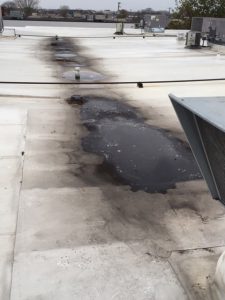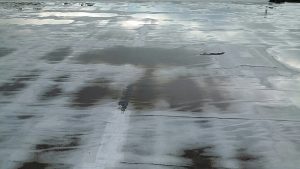— By Anthony Vross —
Addressing ponding water on a heavily penetrated low slope roof.
There are essentially two ways water leaves a roof: positive drainage or evaporation. When neither can occur quickly enough, the result is ponding water.

Anthony Vross, Simon Roofing
Ponding water is defined as any water remaining on a roof 48 hours after a rain. Most commonly occurring on low-slope commercial roofs, ponding water can result from poor building/roof design, poor drainage and pockets forming on the roof after a building or substrate settles.
Retail and restaurant facility managers know all too well the importance of resolving ponding water issues.
5 Ways Ponding Water is Damaging to a Roof
Most roofing systems are made of some form of polymer — TPO, EPDM, modified bitumen, PVC and CLP™ being common examples. They all have different performance characteristics, and they’re all susceptible to breaking down over time because of the nature of what they’re exposed to on a day-to-day basis.
 It’s been reported that some membranes deteriorate in normal conditions at a rate of 1 to 1.5 mils per year, so ponding water conditions would result in the membranes being compromised even faster. Specifically, that means the membrane will become brittle, thin and lose its elasticity, which causes the roof system to weaken and lose its waterproofing capabilities. Some single-ply roofing systems can start showing their age in as few as 7 years — even sooner in ponding water situations.
It’s been reported that some membranes deteriorate in normal conditions at a rate of 1 to 1.5 mils per year, so ponding water conditions would result in the membranes being compromised even faster. Specifically, that means the membrane will become brittle, thin and lose its elasticity, which causes the roof system to weaken and lose its waterproofing capabilities. Some single-ply roofing systems can start showing their age in as few as 7 years — even sooner in ponding water situations.
When it comes to restaurants and you combine grease from the roof vents with ponding water, the oxidation process on roof membranes can be even more aggressive and caustic.
Poor roof performance isn’t the only consequence of ponding water. Ignoring ponding water can also lead to:
- Vegetation: Weeds, grasses, algae and other vegetation can begin to form and grow from excess moisture on the roof, which can lead to debris that clogs roof drains and causes further problems.
- Insects: Water attracts insects, plain and simple. Commonly it’s mosquitos, but depending on the part of the country it can be many other types of bugs. When these insects get inside the building your issues and costs to exterminate them worsen.
- Birds: Ponding water is also going to attract birds, and likely accompanying the birds are unwanted noise, excrement and debris.
- Discoloration: Ponding water can discolor a roof over time, particularly a white roof. This can cause a roof’s performance to suffer and make any visible roof less attractive.
- Ice Damage: Ice formations from ponding water may develop and cause physical damage to the membrane.
Improving Drainage is Not the Only Remedy for Ponding Water
Fixing ponding water areas isn’t always as easy as accelerating your drainage. Some drainage systems aren’t designed to handle additional loads of water at a given rate, so you may experience backups. Similarly, when tapering to existing drains you need to ensure the drains are capable of handling the water flow.
 Others methods to improve drainage can be to add more drains, lower areas around the drains or gutter area, and install saddles in between the drains.
Others methods to improve drainage can be to add more drains, lower areas around the drains or gutter area, and install saddles in between the drains.
On retail and restaurant roofs, in particular, the options for remedying ponding water are often complicated because of the placement and large volume of penetrations on the roof: HVAC systems, grease traps, vent stacks, plumbing pipes and more.
When you’re dealing with facilities with multiple units, tapering isn’t always practical because it can be expensive. Tapering involves adding 1/8-inch or 1/4-inch per foot tapered roof insulation to create slope that moves water toward new or existing drains. Most of these buildings are built with very little slope in the roofing deck.
Materials Play a Role in Addressing Ponding Water
More than likely, retail and restaurants have a roof with penetrations all over it. Water flow can be obstructed because of these penetrations, so you almost always experience ponding somewhere. For effective fixes, a greater emphasis should be placed on planning ahead and using superior-rated roofing materials in the most vulnerable areas.
Addressing ponding water through materials includes:
- Thickness: A membrane’s thickness plays a role because we know the polymer is going to deteriorate over time when exposed to the elements. And we also know it’ll deteriorate even quicker when water is added to the equation. So, it stands to reason the thicker the membrane you put down, the longer it can theoretically withstand erosion until it becomes vulnerable.
- Reinforcement: Adding a layer of reinforcement to the membrane, where possible, can strengthen the membrane in the presence of ponding water. It also lessens the ability for water to penetrate the membrane.
- Specific gravity: Everything is relative to water in the chemical world. Work with your roofing provider to choose materials, particularly in ponding water sections of the roof, where its specific gravity is highest. This means the roofing material is heavier than water. The heavier the material compared to water, the better it will be able to shed water away and keep the roof performing at its peak. For ponding water areas, look for a product with high specific gravity, low porosity, superior adhesion and high-tensile reinforcement. Products like these may be too expensive to specify on the entire roof, but they can make fiscal and practical sense in ponding water areas that you know cannot be addressed through proper water movement.
- Color: The color of the material can make a difference. White roofs are not great for ponding areas because they don’t hold the heat; rather, they reflect it. Retaining heat with a darker colored roof, like gray, will help the ponding water evaporate quicker. Even in warmer climates where it’s more practical from a utilities cost savings perspective to specify a white roof, it can make sense to spot color the ponding areas gray.
- Seamless/Penetrations: When ponding water sits above seams or around penetrations, the resulting deterioration makes it more likely for water penetration through these weakest points in a roofing system. Look for materials that are seamless or be mindful to reinforce areas where sheets of material overlap or around penetrations.
- Timing: When you can field-fabricate the roof in a restoration or re-roofing situation, that’s an ideal time to address ponding areas. Take a look when the roof is done and look at the ponding areas where you won’t be able to move water, and address them right there.
Whether or not you have a roof that ponds water, it’s prudent to perform twice-annual inspections. Choose a trusted professional roofer to assess your roof’s condition on a regular basis, perform spot fixes, document issues and determine the optimal timing for intervening with repairs and restorations.
— Anthony Vross is a co-owner of Simon Roofing, one of the largest and longest-operating national roofing manufacturers/contractors in the United States.
